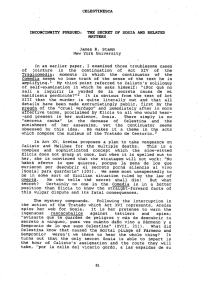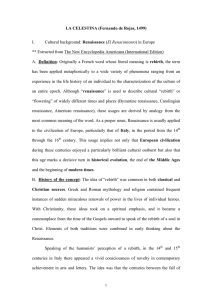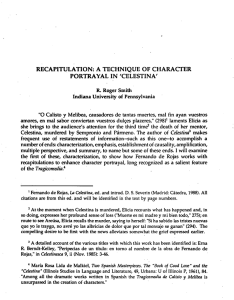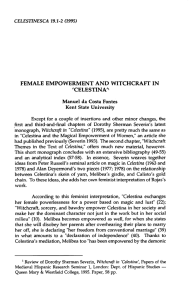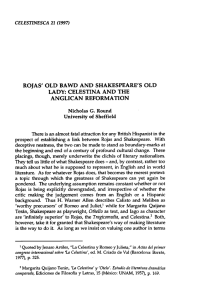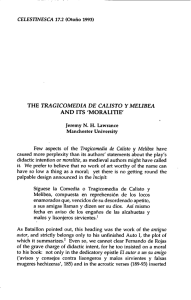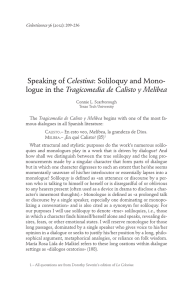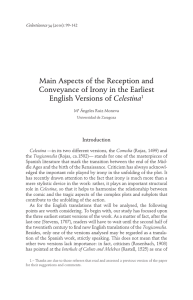The House and Gravesite of Celestina
Anuncio
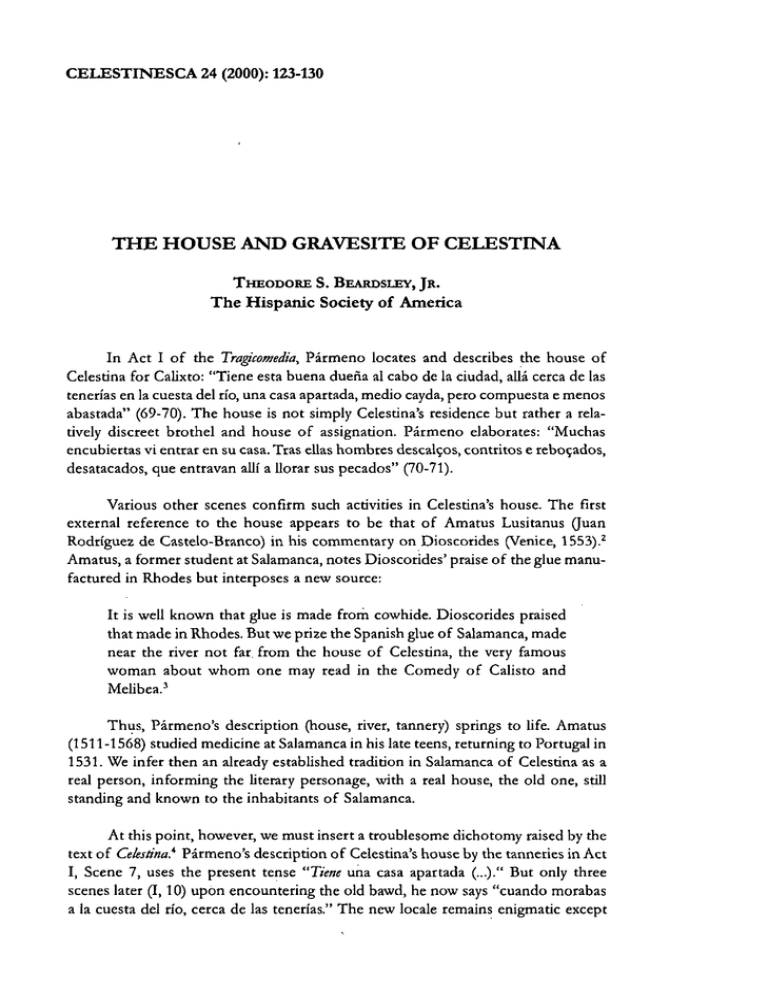
CELESTINESCA 24 (2000): 123-130 THE HOUSE AND GRAVESITE OF CELESTINA THEODORE S. BEARDSLEY, JR. The Hispanic Society of America In Act I of the Tragi'comedia, Pirmeno locates and describes the house of Celestina for Calixto: "Tiene esta buena dueiia a1 cab0 de la ciudad, alli cerca de las tenerias en la cuesta del rio, una casa apartada, medio cayda, pero compuesta e menos abastada" (69-70). The house is not simply Celestina's residence but rather a relatively discreet brothel and house of assignation. Pirmeno elaborates: "Muchas encubiertas vi entrar en su casa. Tras ellas hombres descalsos, contritos e reboqados, desatacados, que entravan alli a llorar sus pecados" (70-71). Various other scenes confirm such activities in Celestina's house. The first external reference to the house appears to be that of Amatus Lusitanus (Juan Rodriguez de Castelo-Branco) in his commentary on Dioscorides (Venice, 1553).2 Amatus, a former student at Salamanca, notes ~ioscorides'praise of the glue manufactured in Rhodes but interposes a new source: It is well known that glue is made from cowhide. Dioscorides praised that made in Rhodes. But we prize the Spanish glue of Salamanca, made near the river not far, from the house of Celestina, the very famous woman about whom one may read in the Comedy of Calisto and Melibea.' Thus, Pirmeno's description (house, river, tannery) springs to life. Amatus (l51 1-1568) studied medicine at Salamanca in his late teens, returning to Portugal in 1531. We infer then an already established tradition in Salamanca of Celestina as a real person, informing the literary personage, with a real house, the old one, still standing and known to the inhabitants of Salamanca. At this point, however, we must insert a troublesome dichotomy raised by the text of Cehstjr~a.~ Pirmeno's description of Celestina's house by the tanneries in Act I, Scene 7, uses the present tense "Tiene una casa apartada (...)." But only three scenes later (I, 10) upon encountering the old bawd, he now says "cuando morabas a la cuesta del rio, cerca de las tenerias." The new locale remains enigmatic except 124 THEODORE S. BEARDSLEY, JR. that it appears to be farther away from the home o f Pleberio than was the house by the tanneries.' The text also indicates that the new house is more luxurious and implies in the Comedia that the move occurred only two years prior to Celestina's visit to Pleberio's home on behalf of Calixto. Nonetheless, the old house by the tanneries is repeatedly mentioned and alluded to in the text for reasons not necessary to plot and seemingly gratuitous. Indeed, after Celestina's murder, in the new Act XV of the Tragicomedia, Elicia announces her intention to remain in business in the new house, thereby "Jamis perderi aquella casa el nombre de Cele~tina."~ But tradition was to decide otherwise. Barely a decade after Amatus' return to Portugal, a very young Sancho de Mufion (Muiiino), "natural de Salamanca" and a student at the university, published his Trajicomedia de Lysandroy Roselia, /.mada Eliciaypor otro nombre quarta obray tercera CelesCna (Salamanca: Juan de Junta, 1542). Like the original we are now dealing with a literary treatment, unjngimiento. Nonetheless, the work offers a few curiosities. One protagonist asks another if he has "oido mentar a Celestina la barbuda (...) aquella que vivia a las tenerias" (980). The dialogue goes on to tell us that Elicia has inherited the old house and the profession (in;luding the equipment and supplies) of Celestina, finally in old age even calling herself Celestina. Thus, jamis perderi aquella casa el nombre de Celestina. . . y muchos extranjeros, que no conocieron a Celestina, la vieja, sin0 de oidas, piensanque es tsta. (981-982) This lore does not end with just the house and Elicia's continuation of the profession. The play tells us where the original Celestina is buried: "si vas a San Laurencio, junto a la pila de baptizar hallaris sobre su sepultura este epitafio" (983).7 The epitajo itself, but for its existence, is of little consequence: Las mientes empedernidas De las muy castas doncellas, Aunque mis altas y bellas, D e mi fueron combatidas; Y ablandadas y vencidas Con mis sabrosas razones, Pusieron sus corazones En mis manos ya rendidas. So color de honestidad Sembrt dafios deshonestos, Arm6 mis lazos compuestos Buscada oportunidad, De cuya perplejidad Lucrecia no se escapara, THE HOUSE AND THE GRAVESITE OF 'CELESTINA' 125 Con mis promesas cebara La penelopea bondad. Si Plut6n a mi llamara, Cien Proserpinas le diera, Sin que trabajo sufriera, Aunque mis le desdeiiara; Pues si de mi se ayudara Fedra en su illicit0 amor, A Hip6lito su dolor En balde no publicara. As Menindez y Pelayo points out "ni la sepultura de Celestina en San Lorenzo, ni su epitafio pueden tomarse en serio," and he adds a significant consideration: "pero son un nuevo document0 de la tradition salamantina."' Thus, Muiion's Tercera Cekstina leaves us with an expanded Salamanca tradition, albeit literary: the continued identification of a specific house by the tanneries in Salamanca attributed to Celestina, an alleged burial site, and a jocose epitaph in verse. The literary identification of the house is carried forward in the Pekgrino curioso (1577) of Bartholomi de Villalba y Estaiia: " [...l baxaron por la puente, que es larguisima y de ahi dieron en las Tenerias, donde con gran chacota dixo uno de ellos al Pelegrino: 'veis aqui la segunda estacion; esta dicen ser la casa de nuestra madre Celestina, tan escuchada de 10s doctos y tan acepta, de 10s mozos tan loada.'" O n the spot, the Pelegrino improvises a new epitaph for Celestina: Reverenciar se debe la morada de quien el mundo tiene tal noticia, mujer que es tan heroyca y encumbrada, quel discreto no quiere su amicicia. De todos 10s estados es loada, y mis de 10s cursados en milicia, filosofo dichoso, y bien andante quien retrato una madre ansi elegante.' Only ten years later, the house appears to have fallen in severe disrepair. Bernardo Gonzilez de Bobadilla ("Estudiante en la insigne Universidad de Salamanca") in his Primeraparte de /as Niqbhasy Pastores de Henares (Alcali, 1587) takes a visitor to see the "cosas memorables que hay en Salamanca" which in addition to "la nombrada y poca vistosa torre de Melibea" includes "la derribada casa de la vieja Cele~tina."~ Mentndez y Pelayo concluded that by this date the house was "arruinada". But there will be further evidence. The tradition of epitaph and possible gravesite continues, for a time without the house. Elsewhere we treat at some length three literary treatments of Celestina 126 THEODORE S. BEARDSLEY, JR. by Francisco de Quevedo. What concerns us here are the opening lines of the first two poems, entitled A Cehtina (c. 1601) and A una ahahwta of subsequent but unknown date. Both poems can be considered to be in the tradition of epitaph for Celestina although it does not seem necessary for Quevedo to have known either of the versions of Muii6n or Villalba. Indeed, the first Quevedo version has been seen as no more than a good example of the epigram tradition in the style of Martial.Io We incline toward the strong possibility of a visit to Salamanca by Quevedo at some time between l601 and 1603 at which point he would assuredly have been shown the ruins of Celestina's house." A Celestina begins "Yace en esta tierra fria, digna de toda crianza," and it would be a simple matter to attribute the hicjacet opening as pure literary formula and no more. It becomes more difficult to make such an assumption in the light of the second poem. A subsequent revised and expanded version of his A Celestina appears in an undated manuscript with the title "A una alcahueta que no quiso la E~tremaunci6n."'~ The first two lines of this version clarify and make more precise the meaning of the opening lines of A Celestina: "Yace aqui, sin obelisco/pobre de ofrenda y de cera." We must recall that Celestina, not likely in a state of grace, called out for "Confesion, confesion!" (II, 111) as she is being murdered. Thus, without the proper ministrations of the church, she could not have been buried in a Spanish cemetery (hallowed ground by definition). Burial options were few, an unmarked grave somewhere in a field or even, perhaps, in her own backyard as it were. If indeed nothing remained of the house, could the site have become in Salamancan tradition the burial plot of a Celestina by now as historical as literary? And to what degree, if any, can the Quevedo poems be viewed as documentation of an attributed gravesite? The matter of Celestina's house is by no means closed. A curious bilingual dialogue constituting an armchair tour of Spain was published by James Howell in the middle of the seventeenth century" Having reached the subject of Salamanca, the speakers mention the well-constructed colkgtos, the Roman bridge, and the bull at the entrance referred to in the L-qado. Charles then asks Philip: "WO vm. alli por ventura la casa de Celestina? [Did you happen to see there the House of Celestina?]." Philip replies: "Seiior, bien me apuntaron el lugar adonde estava, mas no tuve tanta curiosidad que fuera a verla, y tambien me parece que es cosa fingida" [Sir, they pointed at the place where it was, but I had not so much curiosity to go and see it, besides, me thinks it is a famed thing . (22-23)]. The terminus ad quem for Howell's knowledge of the existence of Celestina's house appears to be 1624. If we take Howell's statement at face value ("they pointed at the place where it was [...[ but I has not so much curiosity to g o and see it"), Howell is only testifying to the tradition of a location for the house but without any first-hand knowledge of its physical state at that time. Conversely, his testimony THE HOUSE AND THE GRAVESITE OF 'CELESTINA' 127 does confirm the survival of the tradition. As late as the year 1928 we can confirm the demise of the first house but, perhaps surprisingly, not the disappearance of the tradition of its alleged site. S a k m a n c a y sus costumbres was an illustrated monthly journal devoted to the city and only intended to last for one year, an intention achieved with number 12 in December of 1928. The anxious reader only had to wait until issue 7 @ly) for Celestina to appear. A full page is given to Lapeiia Celestina, with photographs which are identified as "supervivencia del antiguo y derribado murall6n salmantino [fig. 1, p. 1301" The house itself is not mentioned but in leaving the rock, the author reminds us: Y atds, lector, dejamos 10s parajes espisodicos de aquella gran tragedia de Rojas, que si no has leido alguna vez, por 10 menos has oido referir. Ahn parece propicio este lugar, entre la penumbra del anochecer, para 10s comadreos de las viejas, las citas secretas de 10s galanes, 10s lances de espada o las caidas misteriosas desde esta gran altura ... Ahn nos parece sentir 10s pasos cautos de Calixto y su figura recatada que espera en un rincbn a la vieja Celestina, para ultimar 10s detalles de una amorosa trapisonda. Aun nos parece ver la sombra de una dtbil mujer, cubierta con un antifaz, que marcha entre sollozos, apoyada en el hombro decripito de una vieja rechoncha. A6n nos parece oir entre 10s quejidos dtbiles, ag6nicos del galin malaventurado el nombre dulce que sale de sus labios como un suspiro: iMelibea!...l4 Lest there be any doubt, an article in the final issue of the journal, "Un paseo por la Salamanca antigua," takes us back to the rock [fig. 2, p. 1301: "Este enorme, hispido y escarpado peiiasco es la Peiia Celestina (que tambitn se llam6 Santo Toribio), y se alza sobre la ribera de 10s curtidores o de las tenerias, donde habit6 aquella Celestina ensambladora de voluntades y reconstructora de virginidades que con sus artes origin6 la tragedia de Calixto y Melibea."15 How then do we attempt to explain the dilemma of two houses, tradition only accepting the earlier one? Russell gets very close to the point, I think, and is perhaps only missing one detail which does provide a more than plausible reason for the new fictional house of Celestina: "... it seems to me necessary to give serious attention to the hypothesis that the Celestina we think of as a wholly original literary creation may in fact be based on the pre-existing character of a real or legendary Salamancan bawd.believed once to have lived in the house described by the Portuguese doctor. The constant and apparently pointless harping in the text on the exact location of the house in which the bawd used to live becomes entirely explicable if we think of the authors of the book as wishing to establish firmly in the minds of their first readers that the Celestina of their story is based on the character of a real personage 128 THEODORE S. BEARDSLEY, JR. At the Celestina conference at Purdue in late 1991, the closing address was given by Professor Maria Eugenia Lacarra o n the subject of "La evoluci6n de.la prostituci6n en la Castilla del Siglo XV." Amidst a wealth of new facts, Dr. Lacarra cited three documents concerning Salamanca dated in 1498 which, in effect, would prohibit Celestina from exercising her profession in the old house." Those documents alone explain the move, but I suggest there is even more than meets the eye. I agree totally with Professor Russell concerning a real, historical personage o n which. the literary Celestina is built. Indeed, given other early documents concerning prostitution we think it plausible, if not totally necessary, that the real personage was indeed murdered or died under suspicious circumstances thus providing the first death for the Comeda. In that event, the real Celestina must have died before composition of the Comedia, and in view of the dates of the documents, may well have done so in the old house. By virtue of the decrees, her girls would have been obliged to live elsewhere in Salamanca. Thus in mods because of actual circumstances at the time, Celestina on stage was obliged to live in a house she never knew in order to accommodate "the all-important sense of actuality given it by the dialogue form and required (...) by the traditions of both Latin and humanistic comedy."18 In any event, tradition steadfastly refuses to acknowledge the new house and, perhaps we might argue, in so doing lends a bit of credence for a real bawd who once lived and possibly died in kz vieja cma alkporlar tenen'm. If so, where is the body buried? NOTES ' We cite from the often reprinted, easily accessible, edition of Julio Cejador y Frauca, FernanL de Rojas, L-u Celertina (Madrid: Espasa-Calpe). First noted by Doctor Pedro Dias in a Portuguese medical journal (1895) and subsequently by Ricardo Jorge in Nuestro Tiempo 119 (Noviembre 1908), 191-199, cited by MenCndez y Pelayo in Onignes de Ib novela, I1 (Santander, 1943), 277. The original citation was rediscovered independently by Juan Ares Montes. See F. Maldonado de Guevara, "La casa de Celestina," Anales ceryantinor 7 (1958), 287-288. 3"Glutinum quod ex bubulo fit corio, notum est, Rhodium Dioscorides laudat: At nos Hispanum Salmanticense, apud pontem paratum non procul a domo Celestinae mulieris famosissimae, et de qua legitur in comoedia Calisti et Melibeae." See Maldonado (note 2 above). I am especially grateful to Professor Ivy Corfis for her bibliographical advice and also to my colleague, Mitchell Codding. 4See P. E. Russell, "Why did Celestina Move House?' The Age oj the Catholic Monarch~,1474-1516,eds. A. Deyermond and I. MacPherson (L~verpoolUP, 1989), 155-161. See Dorothy Severin and Joseph T.Snow, "La Casa de Pleberio en Salamanca," T H E HOUSE AND T H E GRAVESITE OF 'CELESTINA' 129 Cehstinesca 12.1 (1988): 55-62. We cite from the edition of Manuel Criado de Val in LAs Celestinm (Barcelona: Planeta, 1976). ' "La parroquia de San Lorenzo en Salamanca se halla extramuros" (Criado de Val, p. 983). The location was appropriate for the real site of the alleged house of Celestina, even in Pbrmeno's description placing it "a1 cab0 de la ciudad." Wngenes de la novefa, I I, 278. Ongenes, 278-279. "' See Anthony Giulian, Martial and the Epigram in Spain in the Sixteenth and Sevcnteenth Centuries (Philadelphia, 1930), pp. 52-55. In the spring of 1601, Quevedo abandoned his studies at Alcali and by the summer was in residence in Valladolid where he would remain until after September of 1603 when he had already given A Celesfina to Pedro de Espinosa for his anthology, Flores 1605). See Luis Asuana Marin, La yina turbulenta de Poetas Ilustres de E ~ ~ a n l o(Valladolid, h deQuevedo (Madrid, 1945). l 2 The manuscript in question is entitled Fragmentos no impresos hasta oy. D e Don Francisco de Quevedo (Biblioteca Menindez y Pelayo, Santander, Ms. 108). Both A Celestina and Alcahueta are reproduced in Volume I of the Obras comphtm edited by Josi Manuel Blecua (Barcelona, 1968), 1146 and 1148. A Welshman, Howell graduated from Oxford (1613) and a few years later was sent by his employer on a business trip to the continent (including Spain) where he lingered until 1622. Late that year he was sent to Madrid by a new employer, returning in 1624. There is no record of a subsequent trip to Spain. We cite from a rare copy in The Hispanic Society of America (126/H83) without place or date of publication: ].(am) H.(owelJ, LA Pmbukaiiin lie E ~ ~ a t i acie , y Portugak en un Dimrso entre Carlosy FelipelThe Perambulation of Spain and Portugak In a Discours 'iwixt Char/esanliPhiffi): Whichmay servefor a Directory How to Travel through those Countrqs (1645?). l 4 Antonio Sinchez Gonzilez, "La Peiia Celestina," Salamancay sus costumbres 7 (julio, 1928), pp. 12-13. I s Vicente Marcos, "Un paseo por la Salamanca antigua," Safamancaysus costumbres, 12 (diciembre, 1928), p. 17. l6 P. E. Russell, pp. 159-160. l' Maria Eugenia Lacarra, "La evoluci6n de la prostituci6n en la Castilla del Siglo XV," in Fernando de Rojas and Celestina: Approaching the F$h Centenary, eds. I . A. Corfis and J. T. Snow (Madison: HSMS, 1993), pp. 61-64. l 8 Russell, p. 160. " 130 THEODORE S. BEARDSLEY, JR. C a l k de San Juan de Alchzar y PeAa Celestina. Peiia Celestina
